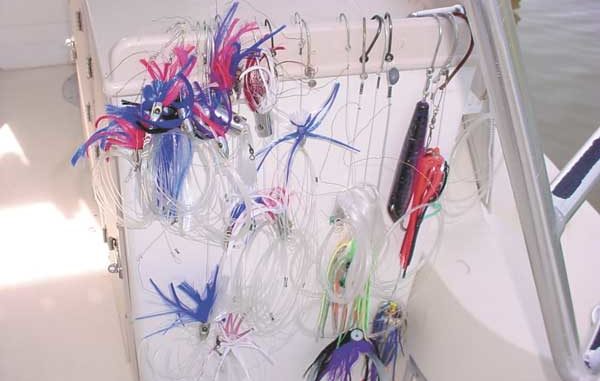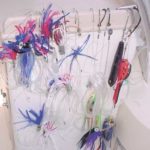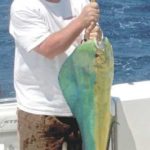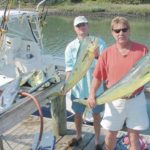
Cape Lookout’s offshore waters provide plenty of gaffer mahi action during May.
Half the Sea Sun Ticket’s trolling lures were still dry when a shiny Penn International howled its “got-one-on” song last May.
The clicker ratcheting of the big trolling reel parlayed a sense of urgency — someone needed to be strapped in a fighting belt to handle this fast-running fish.
An old custom, especially if one wants to be re-invited, is to allow a boat owner to catch the first fish. Because the Sea Sun Ticket belonged to David Bradley, former owner/operator of Sportsman’s Pier, he was the first angler into the batter’s box.
Although he took a few extra seconds to leave the wheel and get into the cockpit, he was primed and ready to go.With a strong and steady grip, he tugged the rod with the protesting reel from its gunwale holder and slipped its butt into the gimbal of his fighting belt.
We’d been fishing only a couple of minutes when an inquisitive fish came calling and tried to abscond with a ballyhoo. Hopefully, this early strike would be a sign of things to come.
Bradley’s adrenaline was nearly maxed out when the dolphin jumped to show itself. While it wasn’t a huge fish, it was a gaffer that tuned up the Penn’s clicker and our intensity level when it stripped line during a first run.
The jump marked the end of that first attempt at escape. When the mahi splashed into the water, Bradley eased forward the drag lever, bent the rod into an arc and went to work.
After a few minutes of pumping and cranking, small beads of sweat appeared on Bradley’s forehead. But he knew a little muscle strain was a small price to pay to handle the torqued rod, complete with a screaming reel and a jumping dolphin at the other end. Moreover, it was nice to have patience rewarded with an almost immediate strike.
While the 29-foot Seaswirl with a walk-around cuddy cabin had handled the seas well, they were somewhat rougher than anticipated and forced Bradley to cruise at a slower speed than usual. By the time we arrived at our destination (a little northeast of the Big Rock), the sun already had climbed well into the eastern sky.
Doug Leister cleared a line that had only half a bait, indicating a strike that hadn’t produced a hookup. He moved another rod to port to give Bradley room to lead his fish to the starboard side of the transom.
By now Bradley’s fish had worn down enough to be turned toward the boat, and he steadily retrieved line.
As the tired mahi succumbed to Bradley’s efforts, he led the pretty fish to the boat where Leister wrapped the leader and reached for the gaff with his free hand.
“Hey, let’s let it stay in the water just a little to see if any (other dolphin) follow,” Bradley said. “You know how dolphin sometimes do; give it just a minute or so to see if any others move in.”
After waiting a minute or so but not wanting the tired dolphin to regain its energy, Leister slipped the gaff over the side and into position. The next time the dolphin’s side faced the surface, Leister buried the point just behind the dolphin’s head and lifted the fish into the boat.
While the dolphin was coming across the gunwale, Bradley relaxed and allowed himself a self-congratulatory “Oh yeah.” The first fish of the day had found the boat and was about to go into the fish box.
A good trip was about to get better.
“We had another bait bitten off and missed the hook,” Leister said as he worked the lines back to their proper trolling positions.
“These suckers are quick and can be tricky,” Leister said. “It amazes me how often they can strike and manage to miss the hooks.”
Leister then asked Bradley to re-rig the baits while he turned the boat to get other baits into position.
Once the baits had been re-rigged and lines properly trailed in the spread, Bradley swung the Sea Sun Ticket 180 degrees and headed for the spot of the initial dolphin attack that morning.
We hadn’t quite trolled back to the “X” on the GPS chart-plotter’s screen when a version of fishing pandemonium occurred.
First, the port out-rigger line snapped as the line popped free and bent the rod deeply as a reel wailed. Although Leister’s turn to catch a fish had arrived, before we could get him buckled, more strikes occurred. Another loud pop signaled a strike on the starboard out-rigger, but that fish pulled free. Then one of the transom rods buckled over, punctuated by a screaming reel, complete with a jumping dolphin at the end of that line.
Then another fish struck the starboard short line, but mercifully it didn’t become impaled on a hook.
With only three of us onboard, someone needed to be free to run the boat and handle the gaff.
By now I was wielding a rod with a running fish as Bradley scrambled to guide the boat and clear other lines. To make matters even more difficult, we’d been headed into the wind, so it was a minute or longer before Bradley could swing the boat enough to leave it idling in gear and be available to help.
Had another hungry dolphin been in that pack, we could have been in a spot of trouble. We managed to land the pair we were fighting before attracting another mahi.
Over the course of the next few hours, dolphin snapped every bait deployed in the spread several more times. Unfortunately, our hook-up ratio wasn’t good as we boated about half of the fish that attacked our baits. Most of these dolphin were at the small end of the size range most anglers call “gaffer” dolphin.
The ballyhoo were mostly near the large end of the sizes packaged as medium (12-pack) baits. The odds were stacked against us as this definitely wasn’t the ideal combination for maintaining a high catch-to-strike ratio.
We’d trolled through several areas of scattered and broken grass the current and wind had broken up or not yet pushed together. A couple of times larger grass clumps with various pieces of flotsam held two or three dolphin, but we couldn’t seem to locate a school.
“I sure wish we could get a school of them up and hungry,” Leister said. “I’d like to have a tuna or two, but there isn’t anything wrong with having a bunch of dolphin to eat.
“If we could get a school around the boat and start bailing them, it sure would be fun. They’re a little on the large side to be bailers, but I’m sure we’d find a way if the opportunity presented itself.”
The dolphin bite finally slowed enough that we considered a move to a more productive location.
“Remember the weed line we passed this morning near the 90-Foot Drop?” Leister said. “We came past it hoping to catch a tuna or two, but there have been some good dolphin reports the past few days from that general area. Maybe they’re still there, and we can fill our limits. It’s also on the way home and our run (to shore) will be shorter.”
Bradley agreed and begun a slow turn of the boat’s course.
While the decision had been made to change locations, we agreed to work our way to the new spot at trolling speed. Because this place was near, trolling at 7 knots would put us at the area within an hour. Also because we were in potentially productive waters, we decided to leave the baits in the water and see what we could catch en route.
While working a current rip on the way to the 90-Foot Drop, a fish hit one of the flat lines and sped away quickly but didn’t jump. Because this fish didn’t head for the bottom, we figured it probably wasn’t a tuna but more likely a wahoo.
Both guesses were wrong.
When the fish finally came into view yards behind the transom, we realized we had the correct family but the wrong fish. It was a nice king mackerel that hadn’t moved inshore and made the mistake of trying to dine on a ballyhoo dressed in a Sea Witch that contained a hidden hook.
As he re-rigged that line, Leister said our fishing day was about to end if we found fish at the inshore grass line.
“I didn’t realize how many bites we’d gotten this morning,” he said. “Counting the baits we have out, we’ve got a dozen ballyhoo left. If we find any fish in here, we made a real smart move to come in rather than chase the fish up or down the beach or farther from the inlet.”
We found the line of grass we’d passed earlier that day that had been riding a current offshore. We turned to the west to follow one arm and also worked nearer the inlet.
After traveling about a quarter mile, we came upon a fairly large clump of Sargasso weed with a couple of 2×4 planks floating near its center.
Pointing out the patch of heavy weeds surrounding the two boards, Bradley said this condition was exactly what one should seek when dolphin fishing. He said he hoped the grass held a few fish.
We didn’t see the first dolphin streak from underneath the floating mass to grab a bait, but shortly after the first reel began squalling, we paid attention to the neon streaks when the next pair of mahi charged the baits.
Once again, we couldn’t land all these dolphin, but we’d perhaps learned from previous experience. We bettered our average and landed two of the three dolphin.
Although we continued to troll the weed line, that was the last multiple strike of the day. We fished for 90 minutes and picked up five more mahis.
When we decided not to put out lines again, we were a few fish short of a limit but had enjoyed a great day. We had a few whole baits and had collected pieces from bite-offs in anticipation of finding a school and bailing them. But we chunked the bait pieces overboard to prevent changing our minds and stopping to fish some more.
We had a messy boat and most of a fish box filled with Cape Lookout gaffer dolphin to clean, which would take a while.
Of course, regardless of how tired we might be, we’d smile and whistle while we worked.






Be the first to comment